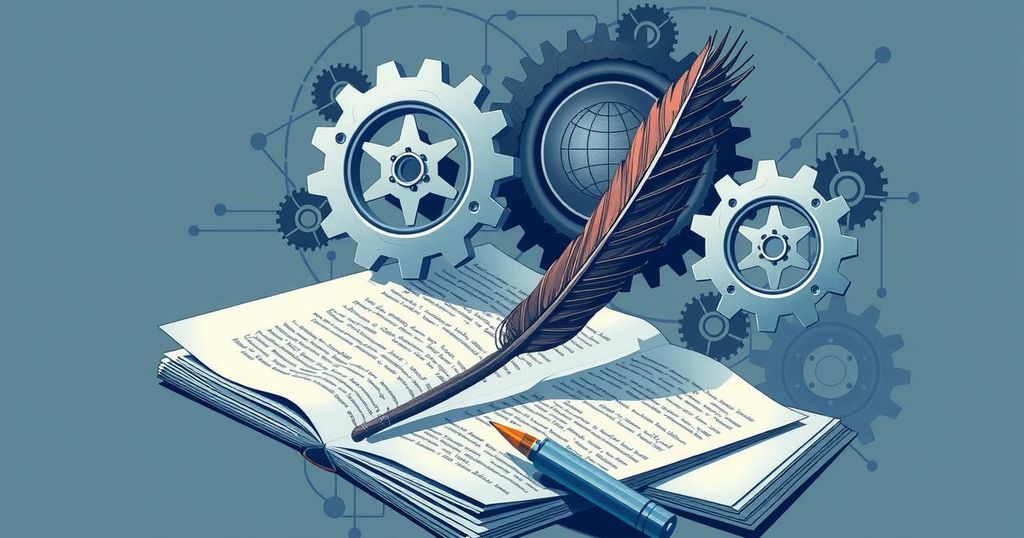The Unavoidable Role of AI in Journalism’s Future
Artificial intelligence is rapidly transforming the journalism industry, presenting both challenges and opportunities for journalists. While AI tools can enhance efficiency and fact-checking, many journalists are hesitant to adopt them due to fears of job loss. Yet, without embracing AI, journalists risk being outpaced in a competitive landscape. Ethical considerations and transparency are crucial as this technology evolves. In the long run, savvy writers can leverage AI as a tool to elevate their work and adapt to a changing world.
In a world where dystopian tales of robots and digital overlords no longer feel far-fetched, artificial intelligence (AI) is weaving itself into the very fabric of our daily lives. With new AI models popping up almost weekly, it sometimes feels as though this technology is racing ahead, outpacing our understanding of it all.
Job security is becoming a big concern as AI quietly replaces countless workers across various sectors. In customer service, healthcare, finance, and even creative industries like journalism, the need for human involvement is fading fast. As machines learn to write, create, and optimize, it raises unsettling questions about the future of jobs that have long been considered secure.
Journalists, perhaps most vulnerable, face a particularly tough challenge. There’s a palpable hesitance among some in the profession to embrace AI tools, viewing them as a threat to the craft and authenticity that define human storytelling. Yet, a plain truth emerges: if journalists don’t harness AI while it’s still a burgeoning resource, others will, and they might just end up sidelined.
To add more weight to the urgency, a report from Bank of America likens the current generative AI stage to the internet’s infancy back in 1996. As technology continues to mature, there’s a risk that deep-pocketed CEOs will leverage AI to trim labor costs, leaving journalists scrambling for relevance. Those in writing-intensive roles, where thoughtful prose can be mimicked by machines in a fraction of the time, are particularly apprehensive.
On the flip side, AI doesn’t just spell doom; it also presents a chance to up journalists’ game. By using AI for background research and fact-checking, reporters can shore up the integrity of their work amidst a surge of skepticism. A 2024 Gallup poll indicates that a striking 69% of Americans express little to no trust in the media—a red flag that underscores the need for credible reporting.
If models like ChatGPT and Claude are programmed with accurate information, they can generate content that’s devoid of bias and helps restore some level of public faith in journalism. Beyond that, these AI powers can aid in automating reporting tasks from drafting articles to transforming raw data into engaging visuals. Resources like Otter.ai highlight this progression, allowing journalists to convert interviews from spoken word to text seamlessly.
But there’s more potential here than just automating mundane tasks. With repetitive work off the table, journalists can dive deeper into researching and infusing their narratives with multimedia elements and varied voices. While AI can assist with brainstorming and generating ideas, it lacks the emotional depth of human insight, which is needed to construct a compelling story. Just check out models like Grok and Visme that churn out impressive visuals—great tools, but they won’t bring the heart of journalism to life.
Still, the landscape isn’t devoid of ethical dilemmas. As AI technology is in its early stages, caution and transparency must guide its use. Journalists need to maintain editorial oversight and let their audiences know when AI has stepped in. There’s also an environmental aspect—AI’s water usage could be staggering, as cited by the University of Illinois Urbana-Champaign, with projections indicating a consumption of 6.6 billion cubic meters of water by 2027. This amount could feed an entire country for a year.
Despite these hurdles, the journalistic landscape still beckons for skilled, crafty writers. The University of North Carolina is adamant that while AI can enhance journalism’s efficiency and accuracy, it cannot replicate the full spectrum of human thought and creativity. Young entrepreneurs like Zach Yadegari are already cashing in on AI-driven innovations, revealing the untapped potential of this technology.
For journalism, the clock is ticking. Navigating through a challenging environment of tight budgets and relentless competition means embracing AI as a survival tool. Creatives within journalism must learn to adapt, harnessing technology not just as a substitute, but as a means to elevate their craft into the new digital age.
In conclusion, while the threat of AI replacing journalists looms large, there’s also significant potential for its integration into the craft. By embracing these tools, journalists can safeguard their roles, enhance the quality of reporting, and potentially rebuild public trust. Balancing ethical considerations with strategic usage will be key moving forward, making it imperative for writers to adapt and innovate or risk becoming obsolete.
Original Source: scotscoop.com




Post Comment